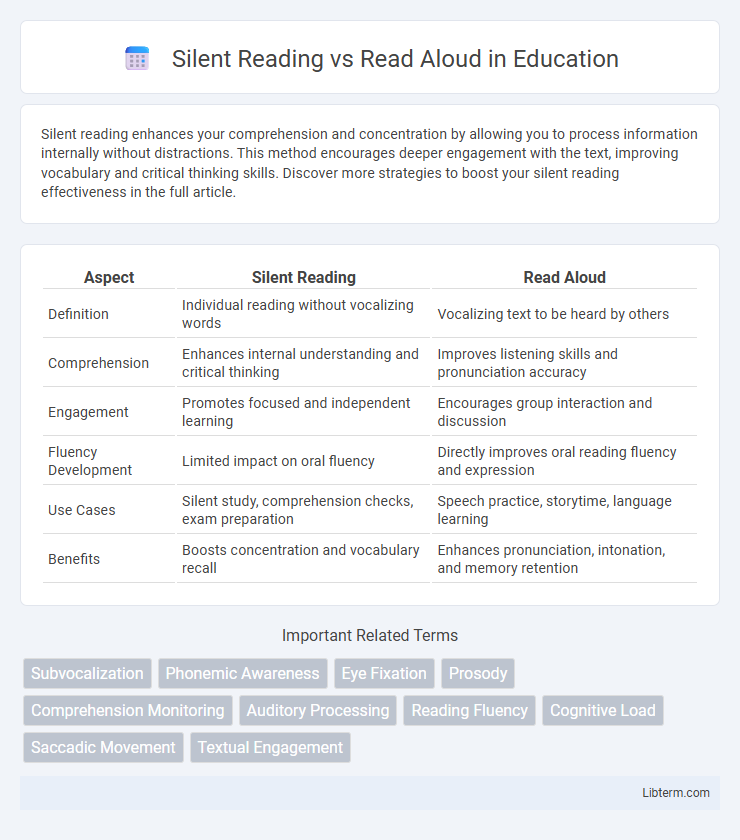Silent reading enhances your comprehension and concentration by allowing you to process information internally without distractions. This method encourages deeper engagement with the text, improving vocabulary and critical thinking skills. Discover more strategies to boost your silent reading effectiveness in the full article.
Table of Comparison
| Aspect | Silent Reading | Read Aloud |
|---|---|---|
| Definition | Individual reading without vocalizing words | Vocalizing text to be heard by others |
| Comprehension | Enhances internal understanding and critical thinking | Improves listening skills and pronunciation accuracy |
| Engagement | Promotes focused and independent learning | Encourages group interaction and discussion |
| Fluency Development | Limited impact on oral fluency | Directly improves oral reading fluency and expression |
| Use Cases | Silent study, comprehension checks, exam preparation | Speech practice, storytime, language learning |
| Benefits | Boosts concentration and vocabulary recall | Enhances pronunciation, intonation, and memory retention |
Introduction to Silent Reading and Read Aloud
Silent reading enhances comprehension by allowing readers to process information at their own pace and develop internal visualization skills. Read aloud improves pronunciation, fluency, and auditory processing through vocal expression and immediate feedback. Both methods contribute uniquely to literacy development and cater to different cognitive and learning preferences.
Cognitive Benefits of Silent Reading
Silent reading enhances cognitive processing by promoting deeper comprehension and engagement with complex texts, facilitating improved working memory and concentration. It allows readers to control pacing, which supports critical thinking and internal visualization, strengthening neural connections related to language and semantic understanding. Studies indicate that silent reading also boosts vocabulary acquisition and decoding skills by encouraging independent problem-solving without external auditory cues.
Advantages of Reading Aloud
Reading aloud enhances comprehension by engaging multiple senses, including auditory and vocal processing, which reinforces memory retention and understanding of the material. It improves pronunciation, fluency, and intonation, providing immediate feedback that helps readers develop stronger language skills. Moreover, read-aloud sessions promote social interaction and listening skills, making them effective for both individual learning and group instruction.
Impact on Comprehension Skills
Silent reading enhances comprehension by allowing readers to process information at their own pace, fostering deeper cognitive engagement and better retention of complex ideas. Read aloud practices improve comprehension through auditory reinforcement, aiding memory and pronunciation while supporting struggling readers in identifying sentence structure and intonation. Combining both methods leverages the strengths of silent decoding and oral expression to develop well-rounded literacy skills.
Silent Reading for Vocabulary Expansion
Silent reading significantly enhances vocabulary acquisition by allowing readers to process words at their own pace, fostering deeper comprehension and retention. Engaging in silent reading exposes individuals to diverse contexts and complex sentence structures, which strengthens word recognition and meaning. Research indicates that consistent silent reading correlates with improved vocabulary growth, outperforming read-aloud methods in supporting independent language development.
Read Aloud for Pronunciation and Fluency
Read aloud practice significantly enhances pronunciation and fluency by allowing learners to hear correct word sounds and intonation patterns, reinforcing accurate speech production. This method engages auditory and vocal muscles simultaneously, promoting muscle memory for clear articulation and smoother speech flow. Regular read aloud sessions also help identify and correct pronunciation errors in real-time, leading to improved confidence and language proficiency.
Silent Reading in Academic Settings
Silent reading in academic settings enhances comprehension and retention by allowing students to process information at their own pace without the distractions of vocalization. Research shows that silent reading improves focus and facilitates deeper cognitive engagement with complex texts, crucial for mastering subject-specific vocabulary and concepts. Implementing silent reading practices supports independent learning, critical thinking, and academic performance across disciplines such as literature, science, and social studies.
Read Aloud Techniques for Young Learners
Read aloud techniques for young learners enhance language acquisition by modeling pronunciation, intonation, and pacing, which supports vocabulary development and comprehension. Interactive read aloud strategies, such as asking predictive questions and encouraging children to mimic expressions, boost engagement and listening skills. Consistent practice with expressive reading fosters phonemic awareness and builds confidence essential for early literacy success.
Choosing Between Silent Reading and Read Aloud
Choosing between silent reading and read aloud depends on the purpose of the reading activity, as silent reading enhances comprehension and concentration by allowing readers to process information internally, while read aloud improves pronunciation, listening skills, and expressive reading. Silent reading suits independent study sessions and develops reading fluency at a personalized pace, whereas read aloud fosters engagement, vocabulary acquisition, and conversational skills in group or classroom settings. Assessing individual learning objectives, reading proficiency, and context helps determine the most effective method for promoting literacy and comprehension growth.
Conclusion: Finding the Right Balance
Finding the right balance between silent reading and read aloud techniques enhances comprehensive language development by combining internal processing with verbal expression. Silent reading fosters deeper comprehension and concentration, while read aloud sessions improve pronunciation, fluency, and auditory learning. Integrating both methods tailored to individual learning needs optimizes reading skills and promotes lifelong literacy.
Silent Reading Infographic

 libterm.com
libterm.com